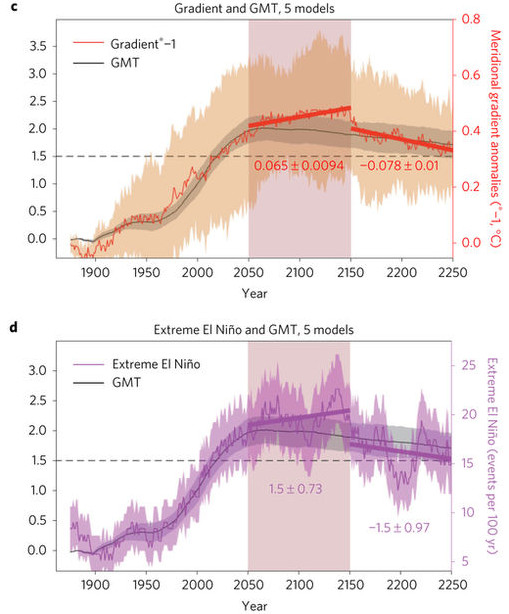Understanding the ultimate risk of extreme El Niño associated with a 1.5˚C warming target
In a paper published in Nature Climate Change (Wang et al., 2017a) we demonstrate that extreme El Niño frequency increases linearly with the GMT towards a doubling at 1.5 °C warming. This increasing frequency of extreme El Niño events continues for up to a century after GMT has stabilized, underpinned by an oceanic thermocline deepening that sustains faster warming in the eastern equatorial Pacific than the off-equatorial region. Ultimately, this implies a higher risk of extreme El Niño to future generations after GMT rise has halted. On the other hand, whereas previous research suggests extreme La Niña events may double in frequency under the 4.5 °C warming scenario8, the results presented here indicate little to no change under 1.5 °C or 2 °C warming.
The Paris Agreement aims to constrain global mean temperature (GMT) increases to 2 °C above pre-industrial levels, with an aspirational target of 1.5 °C. However, the pathway to these targets1,2,3,4,5,6 and the impacts of a 1.5 °C and 2 °C warming on extreme El Niño and La Niña events—which severely influence weather patterns, agriculture, ecosystems, public health and economies7,8,9,10,11,12,13,14,15,16—is little known. Here, by analysing climate models participating in the Climate Model Intercomparison Project’s Phase 5 (CMIP5; ref. 17) under a most likely emission scenario1,2.
 Figure c and d: Temporal evolution of multi-model ensemble mean changes under the RCP2.6 scenario
Figure c and d: Temporal evolution of multi-model ensemble mean changes under the RCP2.6 scenario
Using five models with extended simulations to the 23rd century. The linear trends and their 90% confidence intervals over the 2050–2150 period and the 2151–2250 period indicate that although the GMT decreases, the meridional temperature gradient continues to weaken and the extreme El Niño frequency continues to increase before they reverse (Wang et al., 2017a).